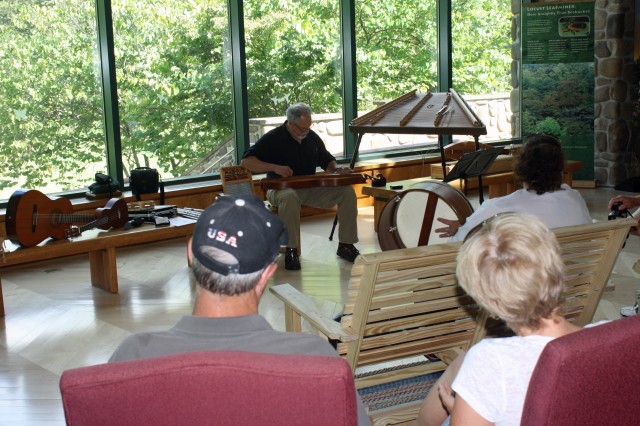The place in which you play your instrument is part of the sound of your instrument --- always.
I could go so far as to say that the location where you’re playing is actually part of your instrument, in the sense that the sounds coming out of your instrument are dispersed to, and return from, surfaces that are sonically connected to the instrument.
Listen for that!
When I’m playing in my living room, a complex environment for sound where there are many absorbent surfaces like rugs and couches, but there is also a flat eight-foot ceiling made of painted sheetrock, plus an opening to an acoustically reflective kitchen, plus a half-open stairway to the second floor, plus a couple of bookcases and a fireplace, plus two big plate-glass windows, plus a tiled foyer in the corner --- I get a complex but pleasantly controlled reflection of sound enhancing my hammered dulcimer or flute, or even Pat Sullivan’s tuba. (But not Peter Budnikas’s bagpipes! We recorded them in a church sanctuary!)
In a hotel meeting room with all its acoustic-deadening ceiling tiles and practically carpeted walls, the instrument’s sound almost disappears!
In a classy restaurant with hard reflective surfaces everywhere, the instrument’s voice blossoms out into near-incoherency! (And all the talking diners get the same effect from their voices, and all this at the same time.)
In the corner of a large room with mostly hard surfaces, the sound is significantly amplified and can be overpowering. This happened the other day as I rehearsed my flute with the Cantori Vocal Ensemble: Even though I played as softly as I could, the chorus couldn’t be heard well enough, so I had to move away from that corner.
Once during a wedding in the Wren Chapel of the colonial-era College of William and Mary, a tall wooden-walled room with slate floors and a plaster ceiling, I played solo a capella flute, and the room sounded glorious! Afterward I mentioned to the organist Tom Marshall, ‘This room seems built for the flute!’ His response: ‘It was!’ And he pointed to the pipe organ, which, of course, is a collection of flutes.
In a forest, the trunk surfaces of individual trees create a distinct aura of sound that does indeed suggest nature in the music!
A concert played in a sonically pleasing room, like an old church, can sound a whole lot better than the same concert in a less pleasing room, like a convention center lobby. Your audience may respond totally differently to what you share with them in these different places, and there’s a good chance they won’t have any idea why! They may just think it’s you, and not a combination of factors. Really.
If you’re a musician, it’s good to develop a sense for these aural environments and to seriously consider how they work together with --- or against --- the sounds coming out of your instrument.
They surely count!
One last thought: What you hear at your instrument as you play probably isn’t the same as what other listeners are hearing. For example, a hammered dulcimer’s sound pours out in all its fullness from the soundboard toward the player’s ears, a couple of feet away; but listeners may be twenty feet away, hearing sounds that slide sideways from the dulcimer and that reflect from distant walls and ceilings (if they’re there at all) --- and the sound may be amazingly different for them! What sounds dynamic and exciting to you may sound soft and soothing to them. One solution is to use microphones and a sound system to amplify the close sound you yourself are hearing, or to turn the instrument around to face the listeners better, or to invite them to come closer. More here.
Another last thought: I find myself playing louder or quieter, faster or slower than I normally might, if a particular location seems to call for that. A tiny room with live walls and listeners close by demands gentle and subtle playing, and a giant space with distant listeners tends to call for big, broad playing. Context, context, context!





Comments